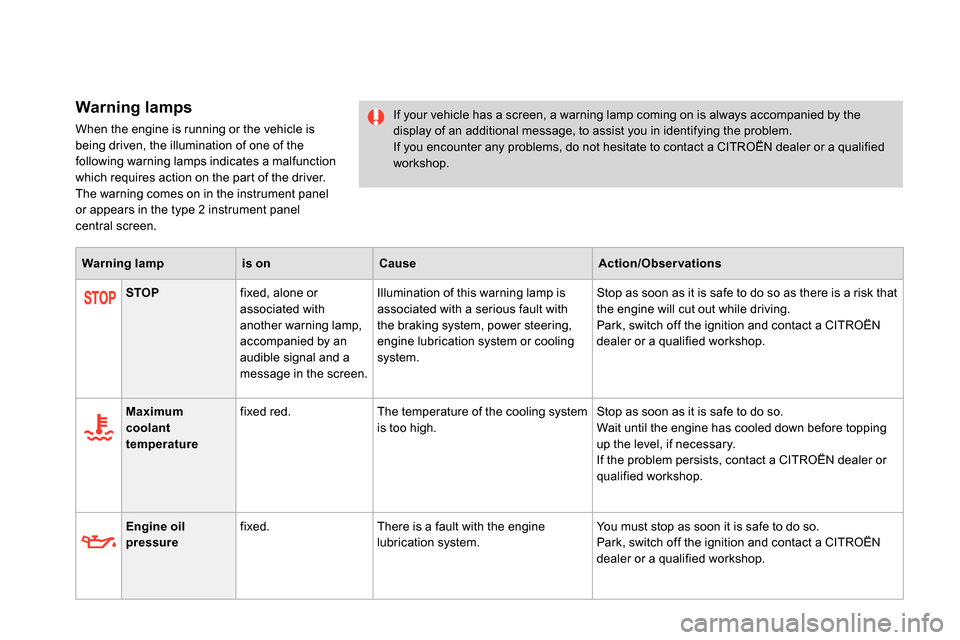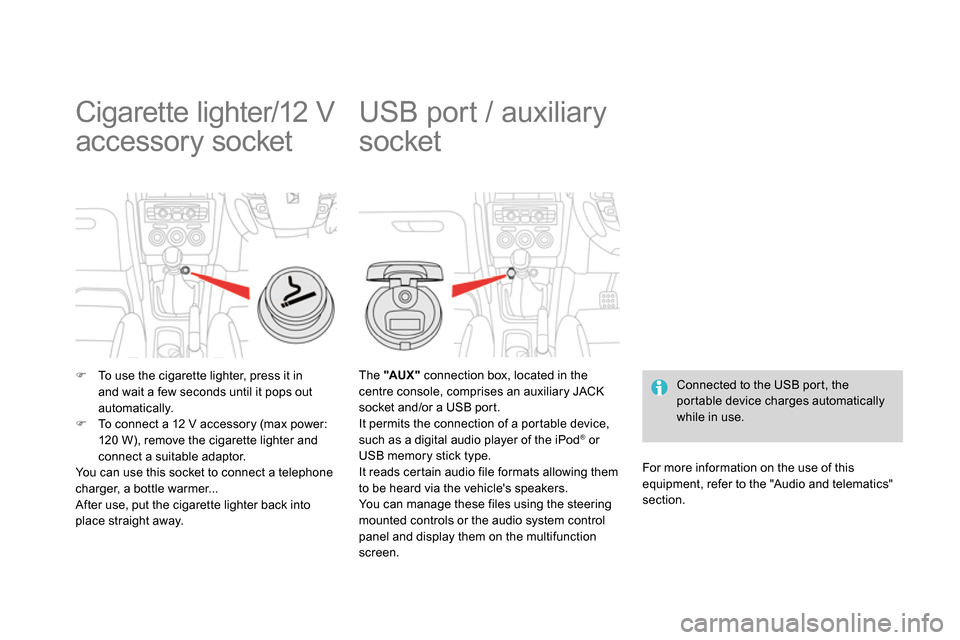2013.5 Citroen DS4 RHD power steering
[x] Cancel search: power steeringPage 46 of 400

Warning lamps
When the engine is running or the vehicle is
being driven, the illumination of one of the
following warning lamps indicates a malfunction
which requires action on the part of the driver.
The warning comes on in the instrument panel
or appears in the type 2 instrument panel
central screen. If your vehicle has a screen, a warning lamp coming on is always accompanied by the
display of an additional message, to assist you in identifying the problem.
If you encounter any problems, do not hesitate to contact a CITROËN dealer or a qualified
workshop.
Warning lamp
is on
Cause
Action/Observations
STOP
fixed, alone or
associated with
another warning lamp,
accompanied by an
audible signal and a
message in the screen. Illumination of this warning lamp is
associated with a serious fault with
the braking system, power steering,
engine lubrication system or cooling
system. Stop as soon as it is safe to do so as there is a risk that
the engine will cut out while driving.
Park, switch off the ignition and contact a CITROËN
dealer or a qualified workshop.
Maximum
coolant
temperature
fixed red. The temperature of the cooling system
is too high. Stop as soon as it is safe to do so.
Wait until the engine has cooled down before topping
up the level, if necessary.
If the problem persists, contact a CITROËN dealer or
qualified workshop.
Engine oil
pressure
fixed. There is a fault with the engine
lubrication system. You must stop as soon it is safe to do so.
Park, switch off the ignition and contact a CITROËN
dealer or a qualified workshop.
Page 51 of 400

49Monitoring
Power steering
fixed. The power steering has a fault. Drive carefully at reduced speed.
Have it checked by a CITROËN dealer or a qualified
workshop.
Under-inflation
fixed. The pressure in one or more wheels
is too low. Check the pressure of the tyres as soon as possible.
This check should preferably be carried out when the
tyres are cold.
+
flashing then fixed,
accompanied by the
Ser vice warning lamp. The tyre pressure monitoring system
has a fault or no sensor is detected
on one of the wheels. Under-inflation detection is not assured.
Have the system checked by a CITROËN dealer or a
qualified workshop.
Directional
headlamps
flashing. The directional headlamps system
has a fault. Have it checked by a CITROËN dealer or a qualified
workshop.
Warning lamp
is on
Cause
Action/Observations
Foot on the brake
pedal
fixed. The brake pedal is not pressed. With an electronic gearbox, press the brake pedal to
start the engine (lever in position N
).
If you wish to release the parking brake without
pressing the brake pedal, this warning lamp will remain
on.
flashing. With an electronic gearbox, if you hold
the vehicle on a rising incline using
the accelerator for too long, the clutch
overheats. Use the brake pedal and/or the electric parking brake.
Airbags
temporarily. This lamp comes on for a few
seconds when you turn on the
ignition, then goes off. This lamp should go off when the engine is started.
If it does not go off, contact a CITROËN dealer or a
qualified workshop.
fixed. One of the airbag or seat belt
pretensioner systems has a fault. Have it checked by a CITROËN dealer or a qualified
workshop.
Page 148 of 400

Cigarette lighter/12 V
accessory socket
To use the cigarette lighter, press it in
and wait a few seconds until it pops out
automatically.
To connect a 12 V accessory (max power:
120 W), remove the cigarette lighter and
connect a suitable adaptor.
You can use this socket to connect a telephone
charger, a bottle warmer...
After use, put the cigarette lighter back into
place straight away.
USB port / auxiliary
socket
Connected to the USB port, the
portable device charges automatically
while in use.
The "AUX "
connection box, located in the
centre console, comprises an auxiliary JACK
socket and/or a USB port.
It permits the connection of a portable device,
such as a digital audio player of the iPod
® or
USB memory stick type.
It reads certain audio file formats allowing them
to be heard via the vehicle's speakers.
You can manage these files using the steering
mounted controls or the audio system control
panel and display them on the multifunction
screen.
For more information on the use of this
equipment, refer to the "Audio and telematics"
section.
Page 218 of 400

Stop & Start
The Stop & Start system puts the engine temporarily into standby - STOP mode - during stops in the traffic (red lights, traffic jams, or other...).
The engine restarts automatically - START mode - as soon as you want to move off. The restart takes place instantly, quickly and silently.
Per fect for urban use, the Stop & Start system reduces fuel consumption and exhaust emissions as well as the noise level when stationary.
Operation
Going into engine STOP mode
With an electronic gearbox, for your
comfort during parking maoeuvres,
STOP mode is not available for a few
seconds after coming out of reverse
gear.
STOP mode does not affect the
functionality of the vehicle, such as
braking, power steering, for example.
Never refuel with the engine in STOP
mode; you must switch off the ignition
with the key. The "ECO"
warning lamp comes on
in the instrument panel and the engine
goes into standby automatically:
- with a manual gearbox
, at speeds below
12 mph (20 km/h), when you put the gear
lever into neutral and release the clutch
pedal,
- with an electronic gearbox
, at a speed
below 5 mph (8 km/h), when you press
the brake pedal or put the gear lever into
position N
.
If your vehicle is fitted with the
system, a time counter calculates
the sum of the periods in STOP
mode during a journey. It resets
itself to zero every time the ignition
is switched on with the key. STOP mode is not invoked when:
- the driver's door is open,
- the driver's seat belt is not fastened,
- the vehicle has not exceeded 6 mph
(10 km/h) since the last engine start using
the key,
- the electric parking brake is applied or
being applied,
- the engine is needed to maintain a
comfortable temperature in the passenger
compartment,
- demisting is active,
- some special conditions (battery charge,
engine temperature, braking assistance,
ambient temperature...) where the engine is
needed to assure control of a system.
Special cases: STOP mode
unavailable
In this case, the "ECO"
warning
lamp flashes for a few seconds, then
goes off.
This operation is per fectly normal.
Page 239 of 400

237Checks
Petrol engines
The various caps and covers allow access for
checking the levels of the various fluids and for
replacing certain components.
1.
Power steering reservoir.
2.
Screenwash and headlamp wash reser voir.
3.
Coolant reservoir.
4.
Brake fluid reser voir.
5.
Battery/Fuses.
6.
Fusebox.
7.
Air filter.
8.
Engine oil dipstick.
9.
Engine oil filler cap.
Page 240 of 400

Diesel engines
The various caps and covers allow access for
checking the levels of the various fluids, for
replacing certain components and for priming
the fuel system.
1.
Power steering reservoir.
2.
Screenwash and headlamp wash reser voir.
3.
Coolant reservoir.
4.
Brake fluid reser voir.
5.
Battery/Fuses.
6.
Fusebox.
7.
Air filter.
8.
Engine oil dipstick.
9.
Engine oil filler cap.
10.
Priming pump * .
11.
Bleed screw * .
*
According to engine.
Page 242 of 400

Coolant level
The coolant level should be close
to the "MA X" mark but should never
exceed it.
When the engine is warm, the
temperature of the coolant is regulated by the
fan.
In addition, as the cooling system is
pressurised, wait at least one hour after
switching off the engine before carrying out any
work.
To avoid any risk of scalding, unscrew the cap
by two turns to allow the pressure to drop.
When the pressure has dropped, remove the
cap and top up the level.
Fluid specifi cation
The coolant must conform to the
manufacturer's recommendations.
Power steering fluid level
The power steering fluid level should
be close to the "MA X" mark. With
the engine cold, unscrew the cap to
check the level. To check the level or top up the
fluid on vehicle fitted with headlamp
washers, immobilise the vehicle and
switch of the engine.
Screenwash / headlamp
wash fluid level
The cooling fan may star t after
switching off the engine: take care
with ar ticles and clothing that might
become caught by the fan blades.
Page 283 of 400

281Practical information
Towing the vehicle
Procedure for having your vehicle towed or for towing another vehicle using a removable towing eye.
The towing eye is installed in the boot under
the floor.
To gain access to it:
open the boot,
raise the floor,
secure it by hooking its cord on the hook on
the rear parcel shelf support,
remove the towing eye from the holder.
Access to the tools
General recommendations
Observe the legislation in force in your
country.
Ensure that the weight of the towing
vehicle is higher than that of the towed
vehicle.
The driver must remain at the wheel
of the towed vehicle and must have a
valid driving licence.
When towing a vehicle with all four
wheels on the ground, always use an
approved towing bar; rope and straps
are prohibited.
When towing a vehicle with the engine
off, there is no longer any power
assistance for braking or steering. In the following cases, you must always call
on a professional recovery ser vice:
- vehicle broken down on a motor way or
fast road,
- 4 wheel drive vehicle,
- when it is not possible to put the gearbox
into neutral, unlock the steering, or
release the parking brake,
- towing with only two wheels on the
ground,
- where there is no approved towing bar
available...